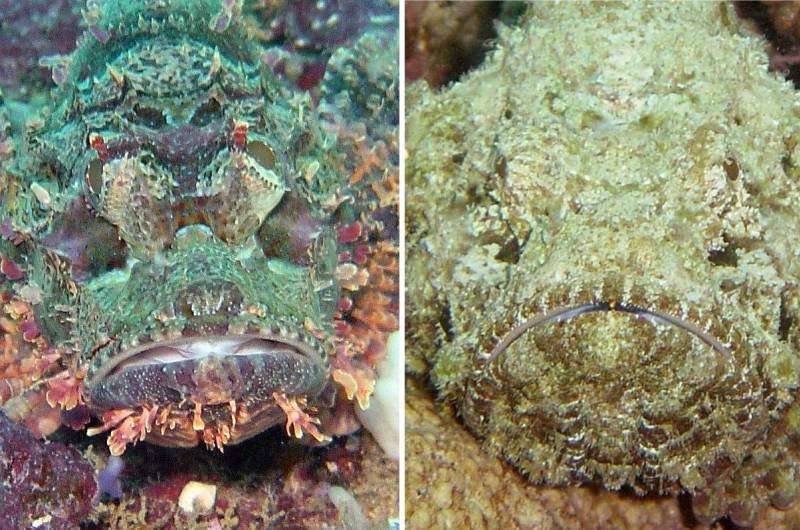The family of Scorpionfish (Scorpaenidae) includes many fascinating species that vary in appearance, behavior and habitat on the reef where they occur.
The scorpionfish family is divided into three main groups:
-
Scorpaena – includes the True Scorpionfish (Scorpaeninae). These fish have spiny, venomous fins and rough, bumpy skin. They are excellent at camouflaging themselves among rocks or coral on the ocean floor. While venomous, they are not aggressive but can deliver painful stings if touched.
- Synanceiinae – Stonefish and Relatives – They look like stones or rocks and are masters of camouflage, often blending into the seafloor to avoid detection. Known for their extremely venomous spines, they are considered among the most dangerous fish.
-
Pterois – Lionfish group, which includes many species that are easily recognizable by their long, flowing fins and venomous spines. They are less dangerous than stonefish but still have painful stings.
Each of these groups belongs to the broader Scorpaenidae family, but they can be quite different.
Scorpionfish in Fiji
Scorpionfish are fascinating creatures found in all the tropical and moderate oceans around the world. Known for their venomous spines, these fish are masters of camouflage, blending seamlessly with their surroundings.
Scorpionfish, with their perfect camouflage, are extremely difficult to see. They are the perfect ambush predators. This means they don’t hunt by swimming after prey, but rather rely on their camouflage, which prevents prey from seeing them in time. When prey comes close enough, they explosively open their mouths, and the resulting vacuum sucks the prey in.
Otherwise, they are typically slow-moving and non-aggressive, and their ability to remain nearly invisible to predators and prey with their “sit and wait” strategy makes it difficult for snorkelers and divers to see them.
Divers and swimmers in Fiji must exercise caution when staying in waters where the species occur to avoid accidentally stepping on these well-disguised creatures, whose venom can cause extreme pain and sometimes long suffering and slow healing.

There are many species worldwide, and dozens of species and subspecies are found on the reefs in Fiji. Even new species are occasionally discovered.
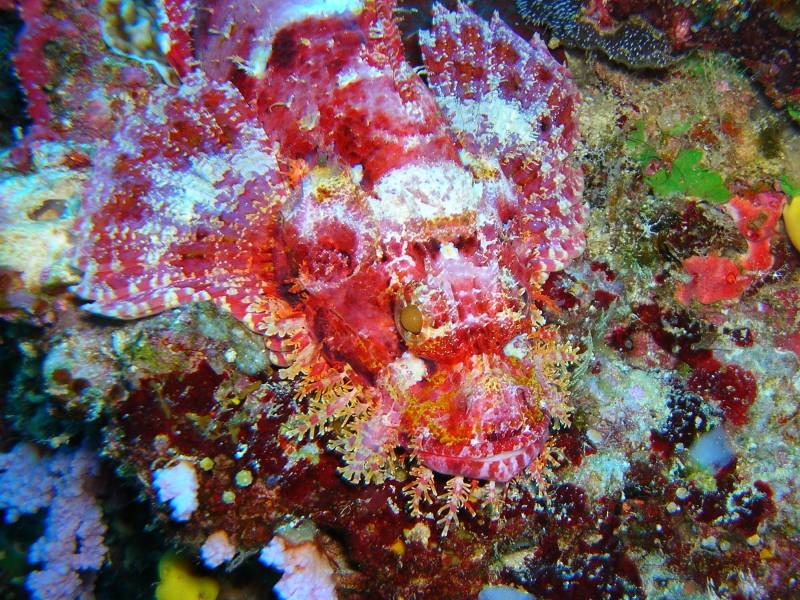
The scorpionfish only look as colorful as they do above in artificial light (flashlight/night diving) or at less than 1 meter of water depth.
Deeper down, the red components of the sunlight are gone, and the fish look like the ones in the following pictures. You can see that their camouflage makes them extremely difficult to see unless you know exactly what to look for.
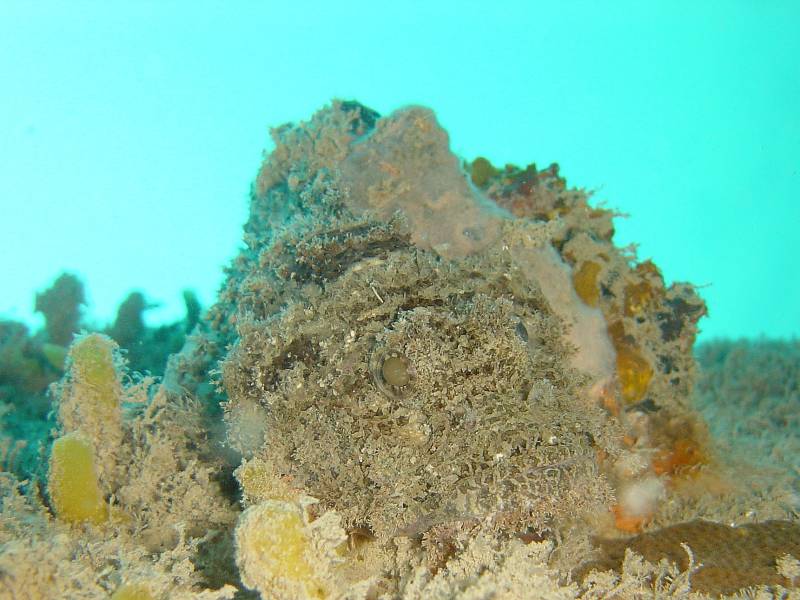
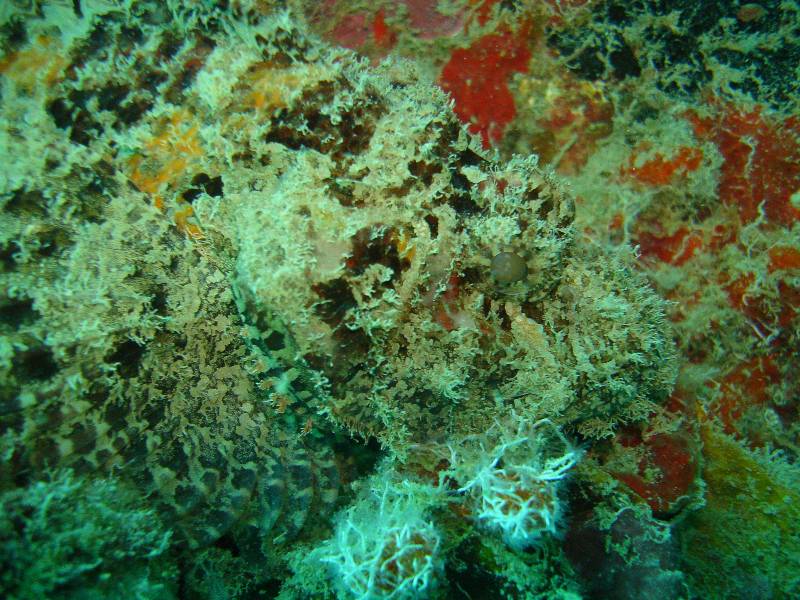
Stonefish in Fiji
Stonefish are also a type of scorpionfish. These venomous fish are highly camouflaged and known for their ability to blend seamlessly into their environment. They typically have rough, bumpy bodies covered with a mix of algae, barnacles, and other marine growth, which helps them mimic the appearance of rocks or stones.
Their coloration ranges from brown to greenish or gray, often with mottled patterns, further enhancing their disguise. Stonefish also have 13 venomous dorsal spines, which protrude from their backs and can deliver a painful sting when stepped on.
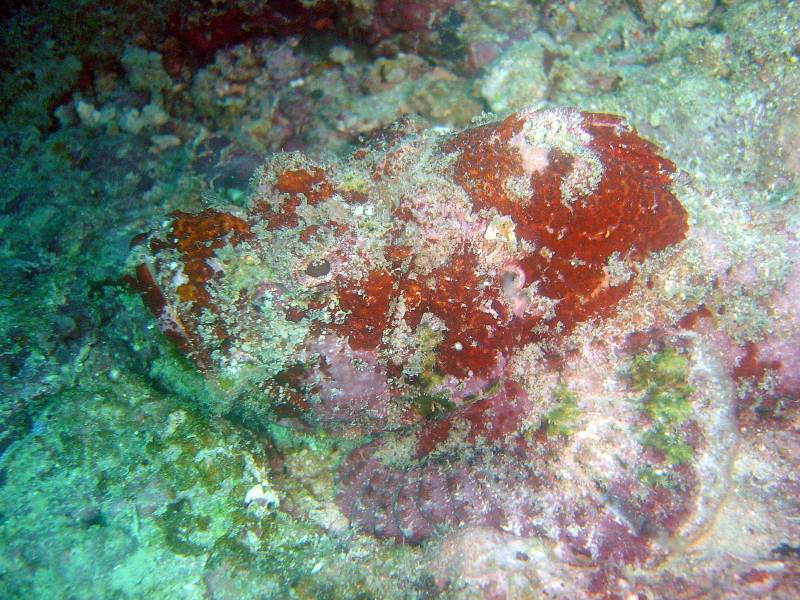
Stonefish are mainly found on rocky seabeds near coral reefs or dead coral areas and occur at a depth of 1 m to depths of up to 30 m.
Their camouflaged appearance makes them hard to spot unless one is specifically looking for them. They are a typical ambush predator, waiting for prey to approach. When prey is within range, the stonefish opens its mouth extremely quickly and sucks in its prey.
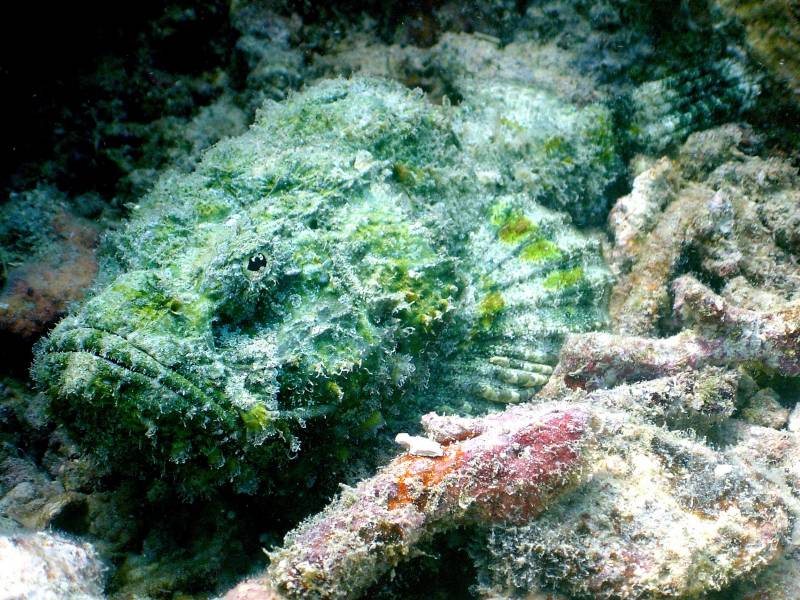
They are not aggressive toward humans, the risk is to accidentally stepping on it. When disturbed, they may remain motionless or try to swim away, but their main defense is the venomous spines, which can deliver a powerful sting as a deterrent to predators or humans.
Scorpionfish vs Stonefish, what’s the difference?
It’s not surprising that the true scorpionfish and stonefish are easily confused, after all, both belong to the Scorpionfish family. But how do you distinguish a scorpionfish from a stonefish?
Scorpionfish have a more elongated body with a broad, spiny head and are often lighter in color, blending into coral reefs or rocky environments. Their fins are large and spiny, with soft, fleshy areas between the spines.
Stonefish, on the other hand, have a more compact, stumpy body and a rough, bumpy texture resembling stones or rocks, making them perfect for camouflage on the sea floor.
A good distinguishing feature is the mouth; the scorpionfish has a calm, expressionless look with its forward-facing mouth, while the stonefish has a grumpy, upward-facing mouth.

Both species belong to the scorpionfish family and, like all members of this family, have several venomous spines that can be splayed out in case of danger. The venom is protein-based and neutralized by high temperatures. The first aid should always be immediate immersion in hot water, if possible. Then seek medical assistance.
To reduce the risk of encounters with stonefish, ask locals for advice on where these fish may occur. When walking in shallow, murky water near rocky bottoms, wear protective footwear, such as thick-soled shoes.
Understanding stonefish behavior and habitat in Fiji is key to ensuring safety for those enjoying the islands’ stunning marine environments. While these creatures are dangerous, with proper knowledge and precautions, visitors can still enjoy Fiji’s vibrant waters safely.
Lionfish in Fiji
The lionfish, is also a member of the scorpionfish family, is one of the ocean’s most striking fish. Recognized by its often redish stripes, fan-like pectoral fins, and long, venomous spines, the lionfish is as beautiful as it is dangerous.
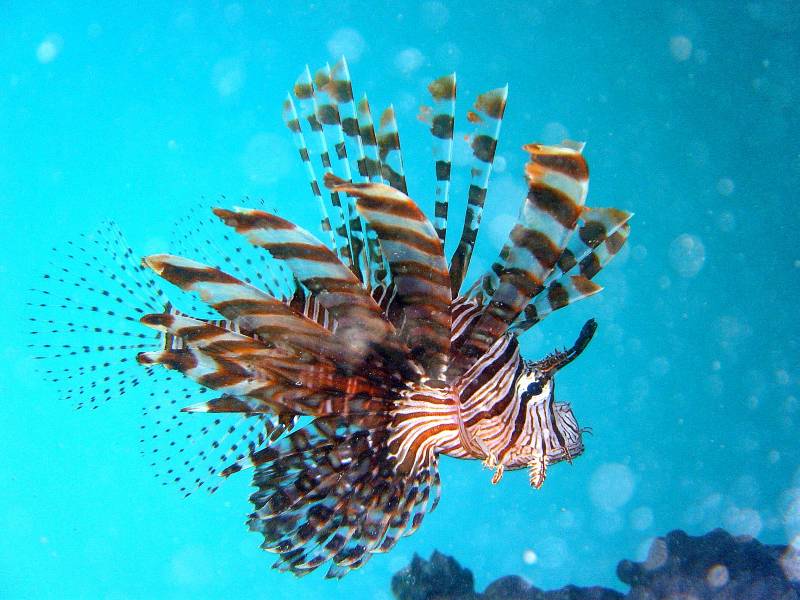
Lionfish are ambush predators, relying on stealth and quick strikes to capture small fish, shrimp, and other crustaceans. A single lionfish can consume dozens of prey in a day, often wiping out juvenile fish populations that are crucial for reef health.
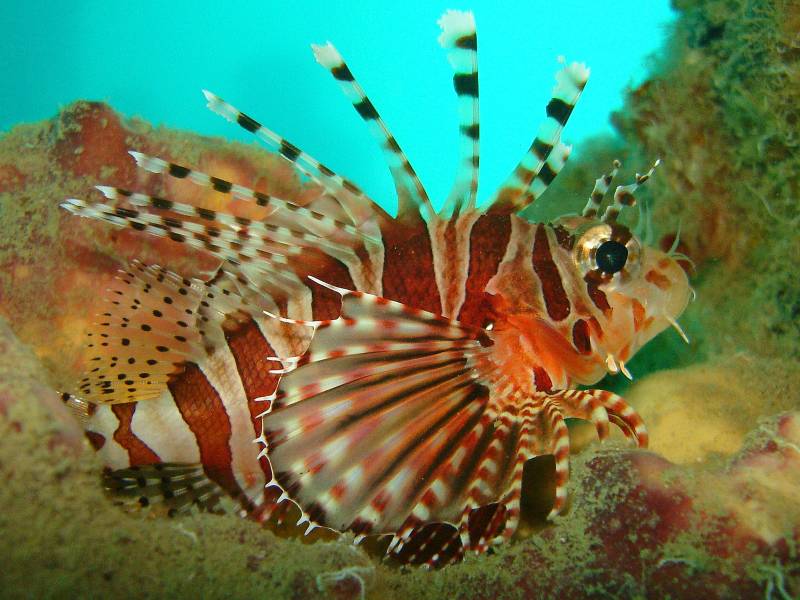
Despite their venomous spines, lionfish are edible. They are consumed by sharks, certain large groupers, large moray eels, and other scorpionfish. Lionfish and stonefish are also eaten by people in some areas. Their white, flaky meat is considered a delicacy in many coastal regions. The venom is neutralized during cooking.
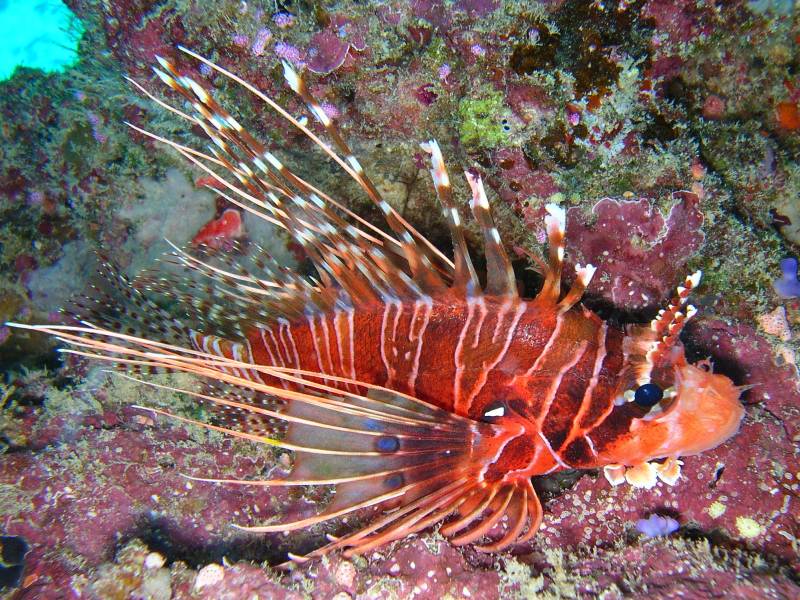
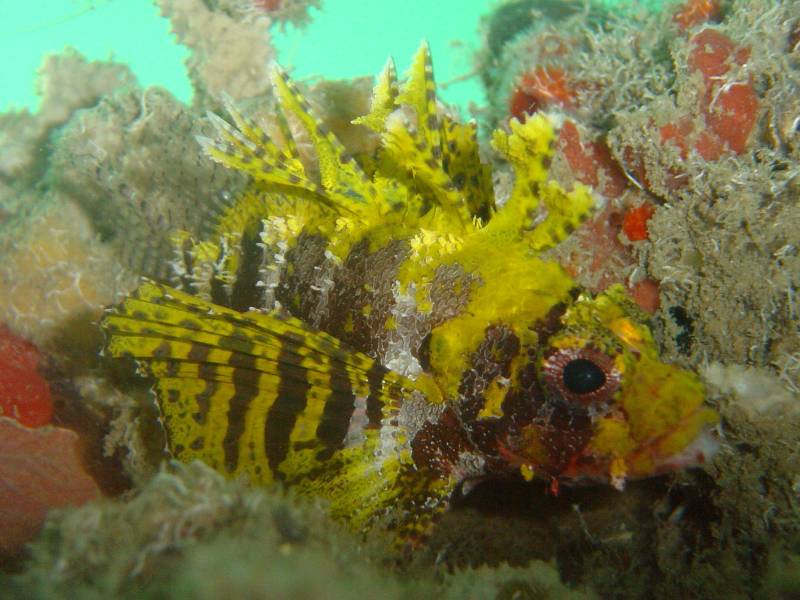
The Dwarf lionfish occurs on the reefs in different colors and appearances, depending on the environment in which it lives
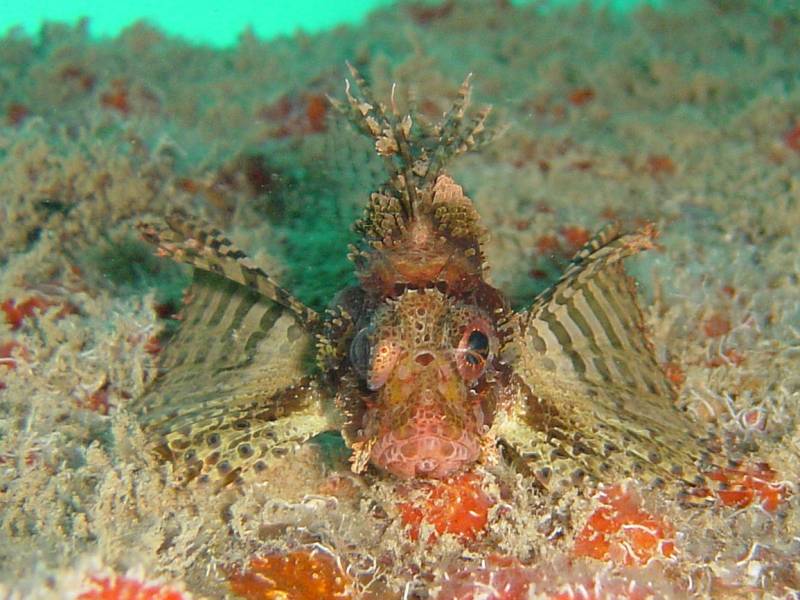
Leaf Scorpionfish (Taenianotus triacanthus)
The leaf scorpionfish (Taenianotus triacanthus) is a small, flat-bodied fish resembling a drifting leaf. This cryptic fish comes in various colors—pink, yellow, brown, or green—and often sways with the current to mimic plant matter.
Although it has venomous spines like other scorpionfish, it relies more on disguise than defense. The leaf scorpionfish feeds on tiny fish and crustaceans, ambushing prey with lightning-fast strikes.
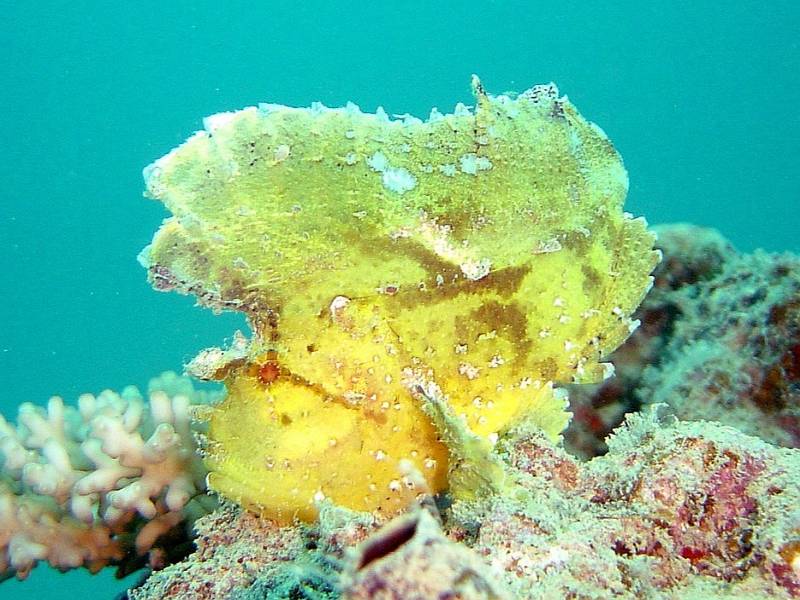
Its unique appearance and behavior make it a fascinating find for divers and underwater photographers.
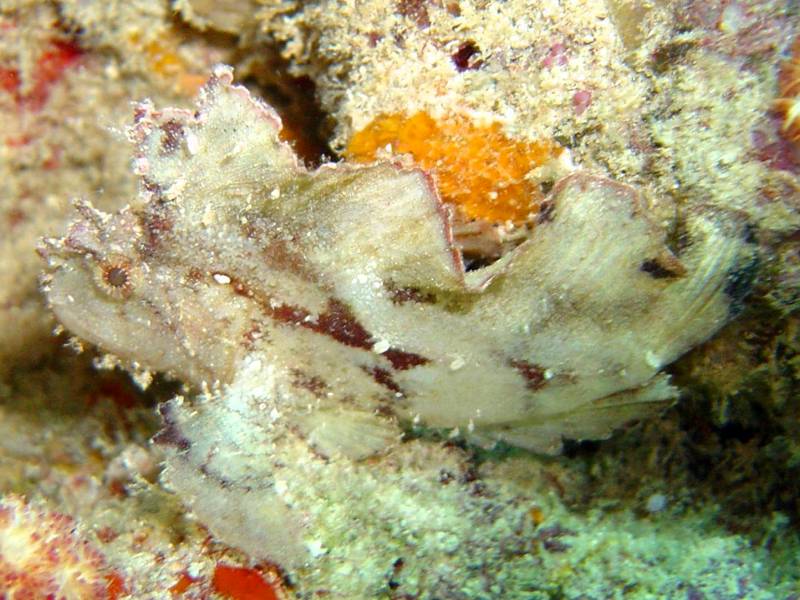
What to do when stung by a venomous Fish?
If you get stung by a venomous fish (like a scorpionfish, lionfish, or especially a stonefish), it’s important to act quickly—not just because it hurts, but because the venom can cause serious reactions.
Here’s what to do, in simple steps:
🛑 1. Get Out of the Water
- Avoid drowning if the pain or reaction is severe.
- Stay calm to reduce the spread of venom through your bloodstream.
🧼 2. Rinse the Wound
- Rinse with clean water (not salt water if you have fresh water available).
- Remove any spines or debris (if safe to do so).
- Don’t press or squeeze the wound.
♨️ 3. Hot Water Soak
- Soak the affected area in hot (not scalding) water—about 110–113°F (43–45°C)—for 30–90 minutes.
- Heat helps break down the venom proteins and reduce pain.
- This is one of the most effective first aid steps for venomous fish stings.
⚠️ 4. Seek Medical Attention
- Especially if:
- Pain is intense or spreading.
- You have trouble breathing, swelling, dizziness, nausea, or signs of an allergic reaction.
- It was a stonefish sting – these can be life-threatening without antivenom.
- A doctor may give pain relief, antibiotics (to prevent infection), or antivenom if needed.
🧊 What Not to Do:
- ❌ Don’t apply ice (it can worsen the venom’s effects).
- ❌ Don’t cut the wound or try to suck out the venom.
- ❌ Don’t delay if symptoms are severe—stonefish venom can be deadly.
